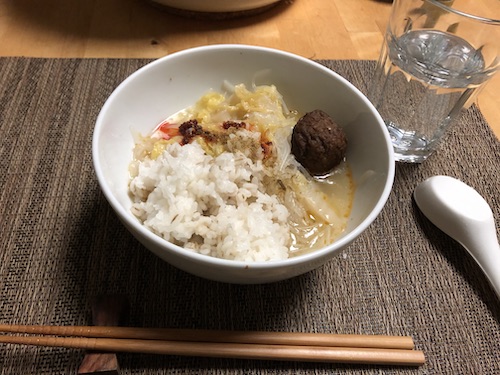bianlu plant-based hotpot
serves 4?
ingredients
- 1 head of napa cabbage
- 100 ml of semame oil
- 5 dried shiitake
- some dried kombu kelp
- 160g vermicelli bean thread
- frozen meatless meatballs
- kosher salt
- chili oil, chili oil with fried garlic, or chili powder
- (optional) cooked white rice
steps
-
put cold water in a large dutch oven with 5 dried shiitake and similar amount of dried kombu kelp. let it sit for a few hours covered.

-
after broth is done, remove the kombu kelp, and pour 1 liter into another pot to set aside for reserve.
-
split the cabbage length-wise in half, then cut each cross-wise in half. then julienne the lower halves into thin strips and put them in the dutch oven.

-
stew the lower halves of cabbage on for 30 min, half covered. start with medium heat and then simmer.
-
in the meantime, roughly chop the leafy part of cabbage into big chunks.

-
add 50ml (~1 ladle) of semame oil and stack the leafy part of the cabbage and simmer for 20 min.

-
the leafy part should’ve shrunk by now. add another 50ml (~1 ladle) of semame oil, mix well, and simmer for 10 min.
-
meanwhile, microwave the frozen meatless meatballs.
-
boil hot water separaly, and soak 4 servings (160g) of vermicelli in a bowl or wok for 5 minutes. drain well and add vermicelli to the cabbage. the hot pot is ready to serve.

how to enjoy bianlu
Serve the stew with meatballs, unseasoned with chili oil and kosher salt on the side.
<img src="/recipes/files/bianlu-serving-1000.jpg"/ style=“width:90%;">
Add just the salt first and enjoy the cabbage. Don’t finish the soup part since it’s a constrained resource.
In the second serving onwards, add chili oil and maybe you can even have some of the soup. If the common soup starts to deplete, you should have the national broth reserve that we’ve set aside. Reheat it and add to the pot.
In the final serving, add some cooked rice (either individually or in the common pot) to make porrige.
about bianlu
扁炉 (bianlu or “pienlo”) is supposedly from Guangxi region in China, and has a cult following in Japan after it was introduced in a book by Kappa Senoh in the 90s. This recipe is based on an adoptation by Oi-san.
For this and other recipes see recipes.